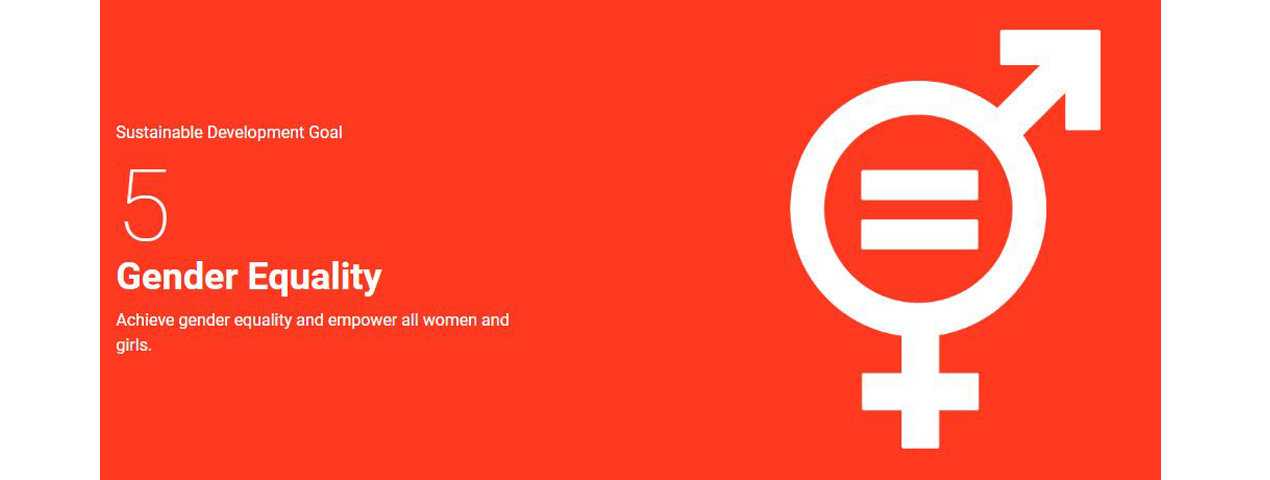Sustainable Development
- Sustainable Development Goals
- No Poverty
- Zero Hunger
- Good Health and Well-being
- Quality Education
- Gender Equality
- Clean Water and Sanitation
- Affordable and Clean Energy
- Decent Work and Economic Growth
- Industry, Innovation and Infrastructure
- Reduced Inequality
- Sustainable Cities and Communities
- Responsible Consumption and Production
- Climate Action
- Life Below Water
- Life on Land
- Peace and Justice Strong Institutions
- Partnerships to achieve the Goal
The Sustainable Development Goals (SDGs) or Global Goals are a collection of 17 interlinked objectives designed to serve as a "shared blueprint for peace and prosperity for people and the planet now and into the future". The SDGs are: no poverty; zero hunger; good health and well-being; quality education; gender equality; clean water and sanitation; affordable and clean energy; decent work and economic growth; industry, innovation and infrastructure; reduced inequalities; sustainable cities and communities; responsible consumption and production; climate action; life below water; life on land; peace, justice, and strong institutions; and partnerships for the goals. The SDGs emphasize the interconnected environmental, social and economic aspects of sustainable development by putting sustainability at their center.
The SDGs were formulated in 2015 by the United Nations General Assembly (UNGA) as part of the Post-2015 Development Agenda, which sought to create a future global development framework to succeed the Millennium Development Goals, which ended that year. They were formally articulated and adopted in a UNGA resolution called the 2030 Agenda, known colloquially as Agenda 2030. On 6 July 2017, the SDGs were made more "actionable" by a UNGA resolution that identifies specific targets for each goal and provides indicators to measure progress. Most targets are to be achieved by 2030, although some have no end date.
There are cross-cutting issues and synergies between the different goals; for example, for SDG 13 on climate action, the IPCC sees robust synergies with SDGs 3 (health), 7 (clean energy), 11 (cities and communities), 12 (responsible consumption and production) and 14 (oceans) Conversely, critics and observers have also identified trade-offs between the goals,such as between ending hunger and promoting environmental sustainability. Other concerns include there being too many goals (resulting in compounding trade-offs), a weak emphasis on environmental sustainability, and difficulties tracking qualitative indicators.
The SDGs are monitored by the UN High-Level Political Forum on Sustainable Development, an annual forum held under the auspices of the United Nations Economic and Social Council. However, it has so far failed to act as an orchestrator to promote system-wide coherence due to a lack of political leadership owing to divergent national interests. To facilitate monitoring of progress on SDG implementation, the online The COVID-19 pandemic had serious negative impacts on all 17 SDGs in 2020; a scientific assessment released in 2022 determined that the world is not on track to achieve the SDGs by 2030 and concluded the SDGs have so far had only limited political effects in global, national and local governance.
1. No Poverty

SDG 1 is to: "End poverty in all its forms everywhere". Achieving SDG 1 would end extreme poverty globally by 2030. A study published in September 2020 found that poverty increased by 7 per cent in just a few months due to the COVID-19 pandemic, even though it had been steadily decreasing for the last 20 years.
The goal has seven targets and 13 indicators to measure progress. The five "outcome targets" are: eradication of extreme poverty; reduction of all poverty by half; implementation of social protection systems; ensuring equal rights to ownership, basic services, technology and economic resources; and the building of resilience to environmental, economic and social disasters. The two targets related to "means of achieving" SDG 1 are mobilization of resources to end poverty; and the establishment of poverty eradication policy frameworks at all levels.
Despite the ongoing progress, 10 percent of the world's population live in poverty and struggle to meet basic needs such as health, education, and access to water and sanitation. Extreme poverty remains prevalent in low-income countries, particularly those affected by conflict and political upheaval. In 2015, more than half of the world's 736 million people living in extreme poverty lived in Sub-Saharan Africa. Without a significant shift in social policy, extreme poverty will dramatically increase by 2030. The rural poverty rate stands at 17.2 percent and 5.3 percent in urban areas (in 2016). Nearly half are children.
2. Zero Hunger

SDG 2 is to: "End hunger, achieve food security and improved nutrition, and promote sustainable agriculture". Globally, 1 in 9 people are undernourished, the vast majority of whom live in developing countries. Under nutrition causes wasting or severe wasting of 52 million children worldwide.It contributes to nearly half (45%) of deaths in children under five – 3.1 million children per year.
SDG 2 has eight targets and 14 indicators to measure progress. The five "outcome targets" are: ending hunger and improving access to food; ending all forms of malnutrition; agricultural productivity; sustainable food production systems and resilient agricultural practices; and genetic diversity of seeds, cultivated plants and farmed and domesticated animals; investments, research and technology. The three "means of achieving" targets include: addressing trade restrictions and distortions in world agricultural markets and food commodity markets and their derivatives.
3. Good Health and Well-being

SDG 3 is to: "Ensure healthy lives and promote well-being for all at all ages".[36] Significant strides have been made in increasing life expectancy and reducing some of the common causes of child and maternal mortality. Between 2000 and 2016, the worldwide under-five mortality rate decreased by 47 percent (from 78 deaths per 1,000 live births to 41 deaths per 1,000 live births).[33] Still, the number of children dying under age five is very high: 5.6 million in 2016.
A 2018 study in the journal Nature found that while "nearly all African countries demonstrated improvements for children under 5 years old for stunting, wasting, and underweight... much, if not all of the continent will fail to meet the Sustainable Development Goal target—to end malnutrition by 2030".
SDG 3 has 13 targets and 28 indicators to measure progress toward targets. The first nine targets are "outcome targets". Those are: reduction of maternal mortality; ending all preventable deaths under five years of age; fight communicable diseases; ensure reduction of mortality from non-communicable diseases and promote mental health; prevent and treat substance abuse; reduce road injuries and deaths; grant universal access to sexual and reproductive care, family planning and education; achieve universal health coverage; and reduce illnesses and deaths from hazardous chemicals and pollution. The four "means to achieving" SDG 3 targets are: implement the WHO Framework Convention on Tobacco Control; support research, development and universal access to affordable vaccines and medicines; increase health financing and support health workforce in developing countries; and improve early warning systems for global health risks.
4. Quality Education
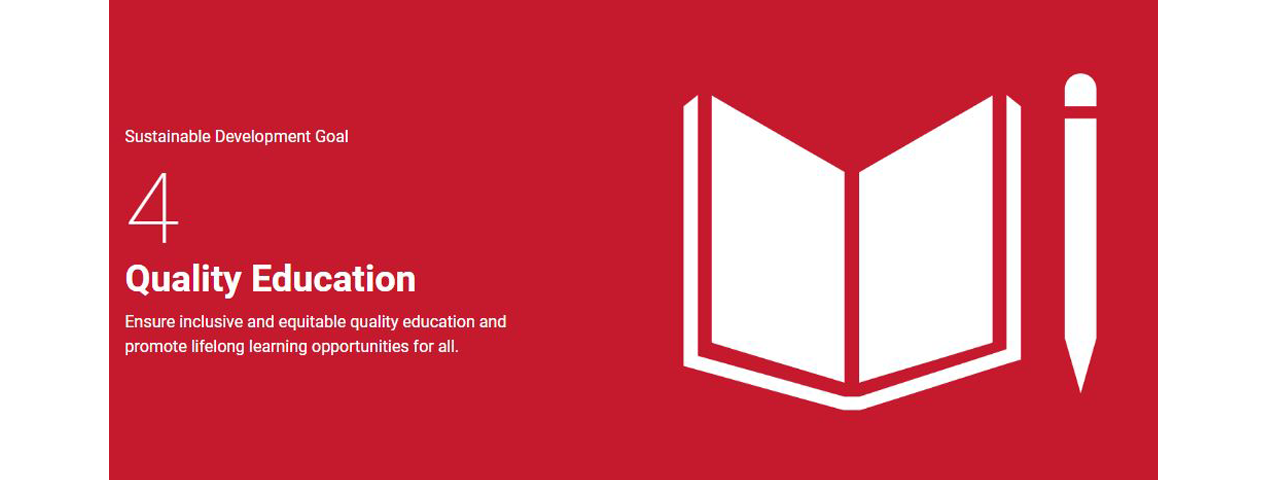
SDG 4 is to: "Ensure inclusive and equitable quality education and promote lifelong learning opportunities for all". Major progress has been made in access to education, specifically at the primary school level, for both boys and girls. The number of out-of-school children has almost halved from 112 million in 1997 to 60 million in 2014. In terms of the progress made, global participation in tertiary education reached 224 million in 2018, equivalent to a gross enrollment ratio of 38%.
SDG 4 has ten targets which are measured by 11 indicators. The seven "outcome-oriented targets" are: free primary and secondary education; equal access to quality pre-primary education; affordable technical, vocational and higher education; increased number of people with relevant skills for financial success; elimination of all discrimination in education; universal literacy and numeracy; and education for sustainable development and global citizenship. The three "means of achieving targets" are: build and upgrade inclusive and safe schools; expand higher education scholarships for developing countries; and increase the supply of qualified teachers in developing countries.
5. Gender Equality
SDG 5 is to: "Achieve gender equality and empower all women and girls". In 2020, representation by women in single or lower houses of national parliament reached 25 per cent, up slightly from 22 per cent in 2015.Women now have better access to decision-making positions at the local level, holding 36 per cent of elected seats in local deliberative bodies, based on data from 133 countries and areas. Whilst female genital mutilation/cutting (FGM/C) is becoming less common, at least 200 million girls and women have been subjected to this harmful practice.
Through the pledge to "Leave No One Behind", countries have committed to fast-track progress for those furthest behind, first. SDG 5 aims to grant women and girls equal rights, opportunities to live free without discrimination including workplace discrimination or any violence. This is to achieve gender equality and empower all women and girls.
6. Clean Water and Sanitation
SDG 6 is to: "Ensure availability and sustainable management of water and sanitation for all".The eight targets are measured by 11 indicators. The Joint Monitoring Programme (JMP) of World Health Organisation WHO And United Nations International Children's Emergency fund UNICEF reported in 2017 that 4.5 billion people currently do not have safely managed sanitation. Also in 2017, only 71 per cent of the global population used safely managed drinking water, and 2.2 billion persons were still without safely managed drinking water. With regards to water stress: "In 2017, Central and Southern Asia and Northern Africa registered very high water stress – defined as the ratio of fresh water withdrawn to total renewable freshwater resources – of more than 70 per cent". Official development assistance (ODA) disbursements to the water sector increased to $9 billion in 2018. Evidence shows that both supply- and demand-side interventions financed by aid can contribute to promoting access to water, but consistent long-term investments are needed.
The six "outcome-oriented targets" include: Safe and affordable drinking water; end open defecation and provide access to sanitation, and hygiene, improve water quality, wastewater treatment and safe reuse, increase water-use efficiency and ensure freshwater supplies, implement IWRM, protect and restore water-related ecosystems. The two "means of achieving" targets are to expand water and sanitation support to developing countries, and to support local engagement in water and sanitation management.
7. Affordable and Clean Energy

SDG 7 is to: "Ensure access to affordable, reliable, sustainable and modern energy for all".Progress in expanding access to electricity has been made in several countries, notably India, Bangladesh, and Kenya.[50] The global population without access to electricity decreased to about 840 million in 2017 from 1.2 billion in 2010 (sub-Saharan Africa remains the region with the largest access deficit).[50] Renewable energy accounted for 17.5% of global total energy consumption in 2016. Of the three end uses of renewables (electricity, heat, and transport) the use of renewables grew fastest with respect to electricity. Between 2018 and 2030, the annual average investment will need to reach approximately $55 billion to expand energy access, about $700 billion to increase renewable energy and $600 billion to improve energy efficiency.
The goal has five targets to be achieved by 2030. Progress towards the targets is measured by six indicators. Three out of the five targets are "outcome targets": Universal access to modern energy; increase global percentage of renewable energy; double the improvement in energy efficiency. The remaining two targets are "means of achieving targets": to promote access to research, technology and investments in clean energy; and expand and upgrade energy services for developing countries. In other words, these targets include access to affordable and reliable energy while increasing the share of renewable energy in the global energy mix. This would involve improving energy efficiency and enhancing international cooperation to facilitate more open access to clean energy technology and more investment in clean energy infrastructure. Plans call for particular attention to infrastructure support for the least developed countries, small islands and land-locked developing countries.
8. Decent Work and Economic Growth
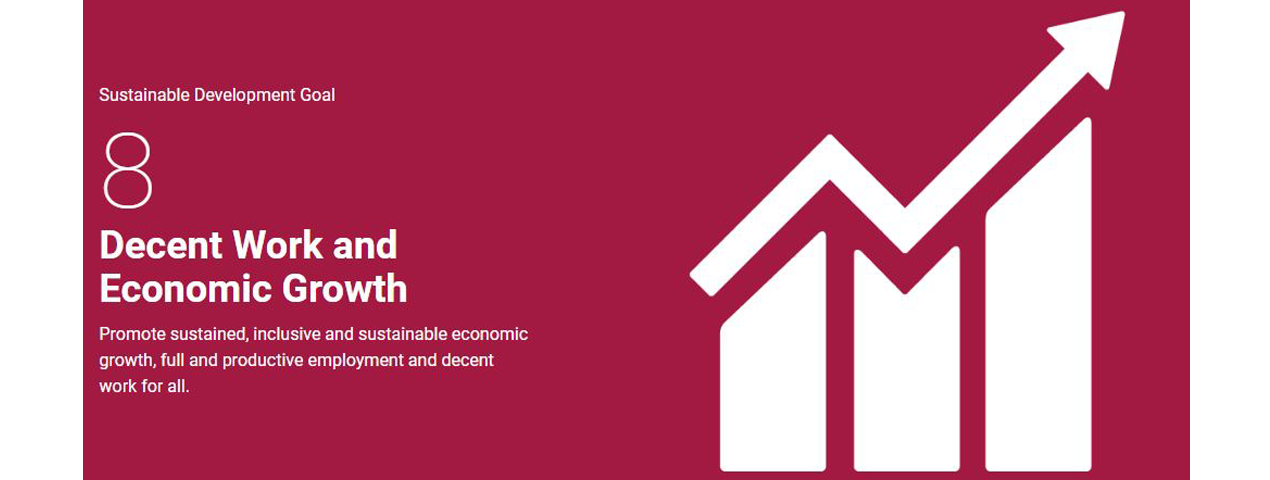
SDG 8 is to: "Promote sustained, inclusive and sustainable economic growth, full and productive employment and decent work for all". Over the past five years, economic growth in least developed countries has been increasing at an average rate of 4.3 per cent. In 2018, the global growth rate of real GDP per capita was 2 per cent. In addition, the rate for least developed countries was 4.5 per cent in 2018 and 4.8 per cent in 2019, less than the 7 per cent growth rate targeted in SDG 8. In 2019, 22 per cent of the world's young people were not in employment, education or training, a figure that has hardly changed since 2005.Addressing youth employment means finding solutions with and for young people who are seeking a decent and productive job. Such solutions should address both supply, i.e. education, skills development and training, and demand. In 2018, the number of women engaged in the labor force was put at 48 per cent while that of men was 75 per cent.
SDG 8 has twelve targets in total to be achieved by 2030. Some targets are for 2030; others are for 2020. The first ten are "outcome targets". These are; "sustainable economic growth; diversify, innovate and upgrade for economic productivity", "promote policies to support job creation and growing enterprises", "improve resource efficiency in consumption and production", 'full employment and decent work with equal pay', 'promote youth employment, education and training', 'end modern slavery, trafficking, and child labour', 'protect labour rights and promote safe working environments', 'promote beneficial and sustainable tourism', universal access to banking, insurance and financial services. In addition, there are also two targets for "means of achieving", which are: Increase aid for trade support; develop a global youth employment strategy.
9. Industry, Innovation and Infrastructure

SDG 9 is to: "Build resilient infrastructure, promote inclusive and sustainable industrialization, and foster innovation". In 2019, 14% of the world's workers were employed in manufacturing activities. This percentage has not changed much since 2000. The share of manufacturing employment was the largest in Eastern and South-Eastern Asia (18 percent) and the smallest in sub-Saharan Africa (6 percent). The intensity of global carbon dioxide emissions has declined by nearly one quarter since 2000, showing a general decoupling of carbon dioxide emissions from GDP growth. As at 2020, nearly the entire world population lives in an area covered by a mobile network. Millions of people are still unable to access the internet due to cost, coverage, and other reasons. It is estimated that just 54% of the world's population are currently internet users.
SDG 9 has eight targets, and progress is measured by twelve indicators. The first five targets are "outcome targets": develop sustainable, resilient and inclusive infrastructures; promote inclusive and sustainable industrialization; increase access to financial services and markets; upgrade all industries and infrastructures for sustainability; enhance research and upgrade industrial technologies. The remaining three targets are "means of achieving" targets: Facilitate sustainable infrastructure development for developing countries; support domestic technology development and industrial diversification; universal access to information and communications technology.
10. Reduced Inequality

SDG 10 is to: "Reduce income inequality within and among countries". In 73 countries during the period 2012–2017, the bottom 40 per cent of the population saw its incomes grow. Still, in all countries with data, the bottom 40 per cent of the population received less than 25 per cent of the overall income or consumption. Women are more likely to be victims of discrimination than men. Among those with disabilities, 3 in 10 personally experienced discrimination, with higher levels still among women with disabilities. The main grounds of discrimination mentioned by these women was not the disability itself, but religion, ethnicity and sex, pointing to the urgent need for measures to tackle multiple and intersecting forms of discrimination. In 2019, 54 per cent of countries have a comprehensive set of policy measures to facilitate orderly, safe, regular and responsible migration and mobility of people.
The Goal has ten targets to be achieved by 2030. Progress towards targets will be measured by indicators. The first seven targets are "outcome targets": Reduce income inequalities; promote universal social, economic and political inclusion; ensure equal opportunities and end discrimination; adopt fiscal and social policies that promotes equality; improved regulation of global financial markets and institutions; enhanced representation for developing countries in financial institutions; responsible and well-managed migration policies. The other three targets are "means of achievement" targets: Special and differential treatment for developing countries; encourage development assistance and investment in least developed countries; reduce transaction costs for migrant remittances.
11. Sustainable Cities and Communities

SDG 11 is to: "Make cities and human settlements inclusive, safe, resilient, and sustainable". The number of slum dwellers reached more than 1 billion in 2018, or 24 per cent of the urban population. The number of people living in urban slums is highest in Eastern and South-Eastern Asia, sub-Saharan Africa and Central and Southern Asia. In 2019, only half of the world's urban population had convenient access to public transport, defined as living within 500 metres' walking distance from a low-capacity transport system (such as a bus stop) and within 1 km of a high-capacity transport system (such as a railway). In the period 1990–2015, most urban areas recorded a general increase in the extent of built-up area per person.
SDG 11 has 10 targets to be achieved, and this is being measured with 15 indicators. The seven "outcome targets" include safe and affordable housing, affordable and sustainable transport systems, inclusive and sustainable urbanization, protection of the world's cultural and natural heritage, reduction of the adverse effects of natural disasters, reduction of the environmental impacts of cities and to provide access to safe and inclusive green and public spaces. The three "means of achieving" targets include strong national and regional development planning, implementing policies for inclusion, resource efficiency, and disaster risk reduction in supporting the least developed countries in sustainable and resilient building.
3.9 billion people—half of the world’s population—currently live in cities globally. It is projected that 5 billion people will live in cities by 2030. Cities across the world occupy just 3 percent of the Earth's land, yet account for 60–80 percent of energy consumption and 75 percent of carbon emissions. Increased urbanization requires increased and improved access to basic resources such as food, energy and water. In addition, basic services such as sanitation, health, education, mobility and information are needed. However, these requirements are unmet globally, which causes serious challenges for the viability and safety of cities to meet increased future demands.
12. Responsible Consumption and Production

SDG 12 is to: "Ensure sustainable consumption and production patterns". By 2019, 79 countries and the European Union have reported on at least one national policy instrument to promote sustainable consumption and production patterns. This was done to work towards the implementation of the "10-Year Framework of Programmes on Sustainable Consumption and Production Patterns". Global fossil fuel subsidies in 2018 were $400 billion. This was double the estimated subsidies for renewables and is detrimental to the task of reducing global carbon dioxide emissions.
To ensure that plastic products are more sustainable, thus reducing plastic waste, changes such as decreasing usage and increasing the circularity of the plastic economy are expected to be required. An increase in domestic recycling and a reduced reliance on the global plastic waste trade are other actions that might help meet the goal.
Sustainable Development Goal 12 has 11 targets. The first 8 are "outcome targets", which are: implement the 10‑Year Framework of Programs on Sustainable Consumption and Production Patterns; achieve the sustainable management and efficient use of natural resources; reducing by half the per capita global food waste at the retail and consumer levels and the reduction of food losses along production and supply chains, including post-harvest losses; achieving the environmentally sound management of chemicals and all wastes throughout their life cycle; reducing waste generation through prevention, reduction, recycling and reuse; encourage companies to adopt sustainable practices; promote public procurement practices that are sustainable; and ensure that people everywhere have the relevant information and awareness for sustainable development. The three "means of achievement" targets are: support developing countries to strengthen their scientific and technological capacity; develop and implement tools to monitor sustainable development impacts; and remove market distortions, like fossil fuel subsidies, that encourage wasteful consumption.
13. Climate Action

SDG 13 is to: "Take urgent action to combat climate change and its impacts by regulating emissions and promoting developments in renewable energy". Accelerating climate actions and progress towards a just transition is essential to reducing climate risks and addressing sustainable development priorities, including water, food and human security (robust evidence, high agreement). Accelerating action in the context of sustainable development involves not only expediting the pace of change (speed) but also addressing the underlying drivers of vulnerability and high emissions (quality and depth of change) and enabling diverse communities, sectors, stakeholders, regions and cultures (scale and breadth of change) to participate in just, equitable and inclusive processes that improve the health and well-being of people and the planet.
The average worldwide temperature in 2021 was approximately 1.1°C higher than pre-industrial levels (from 1850 to 1900). The years from 2015 to 2021 were the seven warmest on record; the top three being 2016, 2019 and 2020. Currently climate change is affecting the global community in every nation across the world. The impact of climate change not only impacts national economies, but also lives and livelihoods, especially those in vulnerable conditions. By 2018, climate change continued exacerbating the frequency of natural disasters, such as massive wildfires, droughts, hurricanes, and floods. Over the period 2000–2018, the greenhouse emissions of developed countries in transitions have declined by 6.5%. However, the emissions of the developing countries are up by 43% in the period between 2000 and 2013. In 2019, at least 120 of 153 developing countries had undertaken activities to formulate and implement national adaptation plans.
SDG 13 and SDG 7 on clean energy are closely related and complementary. The leading sources of the greenhouse gas savings that countries need to focus on in order to fulfill their commitments under the Paris Agreement are switching fuels to renewable energy and enhancing end-use energy efficiency.
14. Life Below Water
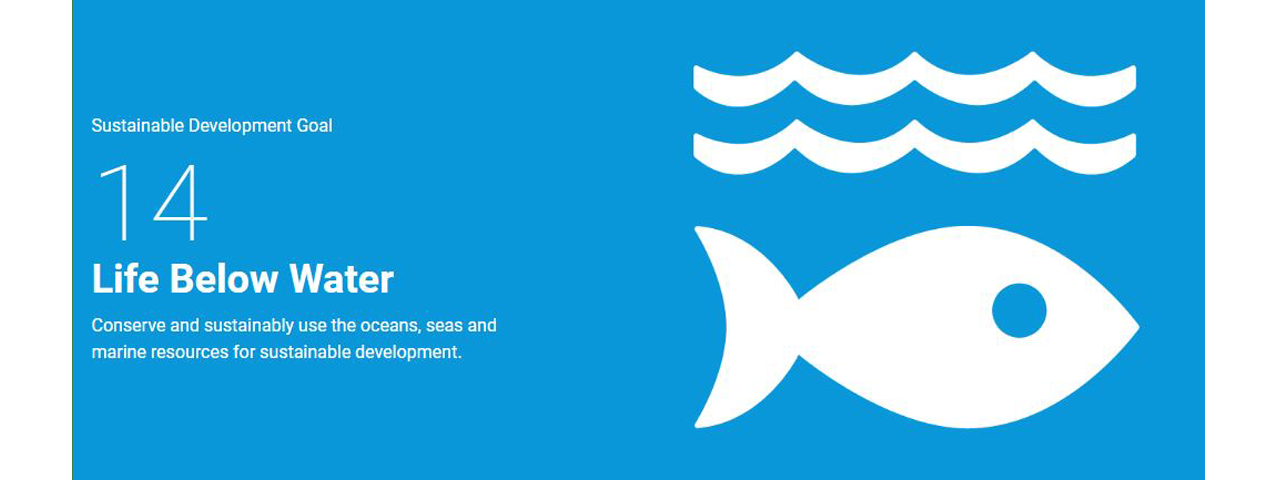
SDG 14 is to: "Conserve and sustainably use the oceans, seas and marine resources for sustainable development". The current efforts to protect oceans, marine environments and small-scale fishers are not meeting the need to protect the resources. One of the key drivers of global overfishing is illegal fishing. It threatens marine ecosystems, puts food security and regional stability at risk, and is linked to major human rights violations and even organized crime. Increased ocean temperatures and oxygen loss act concurrently with ocean acidification and constitute the "deadly trio" of climate change pressures on the marine environment.
One indicator (14.1.1b) under Goal 14 specifically relates to reducing impacts from marine plastic pollution.
The first seven targets are "outcome targets": Reduce marine pollution; protect and restore ecosystems; reduce ocean acidification; sustainable fishing; conserve coastal and marine areas; end subsidies contributing to overfishing; increase the economic benefits from sustainable use of marine resources. The last three targets are "means of achieving" targets: To increase scientific knowledge, research and technology for ocean health; support small scale fishers; implement and enforce international sea law.
Oceans and fisheries support the global population's economic, social and environmental needs. Oceans are the source of life of the planet and the global climate system regulator. They are the world's largest ecosystem, home to nearly a million known species. Oceans cover more than two-thirds of the earth's surface and contain 97% of the planet's water. They are essential for making the planet livable. Rainwater, drinking water and climate are all regulated by ocean heat content and currents. Over 3 billion people depend on marine life for their livelihood. However, there has been a 26 percent increase in acidification since the industrial revolution. Effective strategies to mitigate adverse effects of increased ocean acidification are needed to advance the sustainable use of oceans.
15. Life on Land
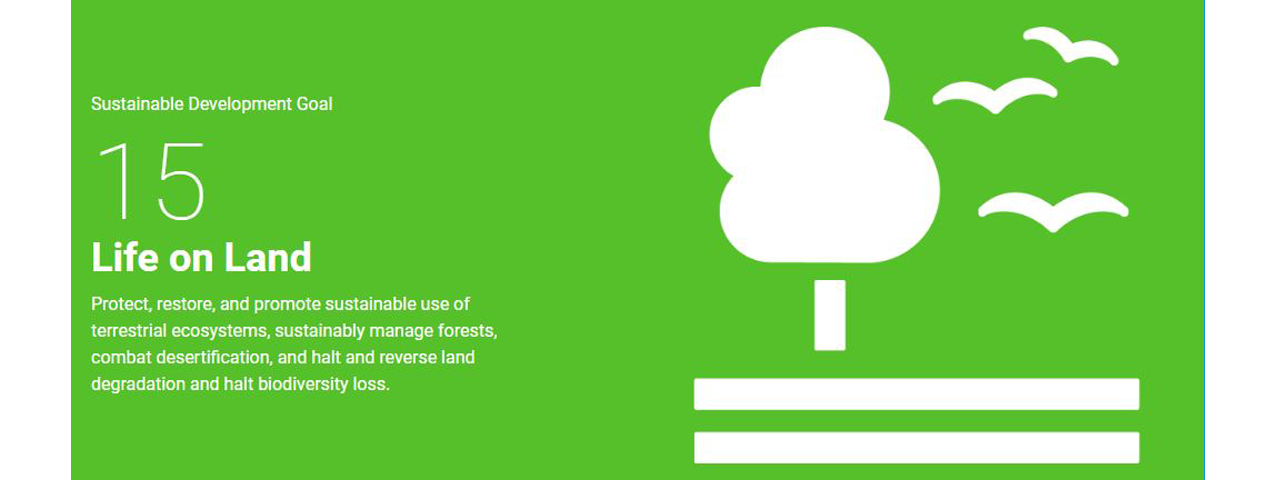
SDG 15 is to: "Protect, restore and promote sustainable use of terrestrial ecosystems, sustainably manage forests, combat desertification, and halt and reverse land degradation and halt biodiversity loss". The proportion of forest area fell, from 31.9 per cent of total land area in 2000 to 31.2 per cent in 2020, representing a net loss of nearly 100 million ha of the world's forests. This was due to decreasing forest area decreased in Latin America, sub-Saharan Africa and South-Eastern Asia, driven by deforestation for agriculture. Desertification affects as much as one-sixth of the world's population, 70% of all drylands, and one-quarter of the total land area of the world. It also leads to spreading poverty and the degradation of billion hectares of cropland. A report in 2020 stated that globally, the species extinction risk has worsened by about 10 per cent over the past three decades.
The nine "outcome targets" include: Conserve and restore terrestrial and freshwater ecosystems; end deforestation and restore degraded forests; end desertification and restore degraded land; ensure conservation of mountain ecosystems, protect biodiversity and natural habitats; protect access to genetic resources and fair sharing of the benefits; eliminate poaching and trafficking of protected species; prevent invasive alien species on land and in water ecosystems; and integrate ecosystem and biodiversity in governmental planning. The three "means of achieving targets" include: Increase financial resources to conserve and sustainably use ecosystem and biodiversity; finance and incentivize sustainable forest management; combat global poaching and trafficking.
Humans depend on earth and the oceans to live. This goal aims at securing sustainable livelihoods that will be enjoyed for generations to come. The human diet is composed 80% of plant life, which makes agriculture a prime economic resource. Forests cover 30 percent of the Earth's surface, provide vital habitats for millions of species, and important sources for clean air and water, as well as being crucial for combating climate change.
16. Peace and Justice Strong Institutions

SDG 16 is to: "Promote peaceful and inclusive societies for sustainable development, provide access to justice for all and build effective, accountable and inclusive institutions at all levels". With more than a quarter of children under 5 unregistered worldwide as of 2015, about 1 in 5 countries will need to accelerate progress to achieve universal birth registration by 2030. Data from 38 countries over the past decade suggest that high-income countries have the lowest prevalence of bribery (an average of 3.7 per cent), while lower-income countries have high levels of bribery when accessing public services (22.3 per cent).
The goal has ten "outcome targets": Reduce violence; protect children from abuse, exploitation, trafficking and violence; promote the rule of law and ensure equal access to justice; combat organized crime and illicit financial and arms flows, substantially reduce corruption and bribery; develop effective, accountable and transparent institutions; ensure responsive, inclusive and representative decision-making; strengthen the participation in global governance; provide universal legal identity; ensure public access to information and protect fundamental freedoms. There are also two "means of achieving targets": Strengthen national institutions to prevent violence and combat crime and terrorism; promote and enforce non-discriminatory laws and policies.]
Reducing violent crime, sex trafficking, forced labor, and child abuse are clear global goals. The International Community values peace and justice; they call for stronger judicial systems that will enforce laws and work toward a more peaceful and just society.All women need to be able to turn to fair and effective institution to access Justice and important services. We cannot hope for sustainable development without peace and stability in any country.
17. Partnerships to achieve the Goal

SDG 17 is to: "Strengthen the means of implementation and revitalize the global partnership for sustainable development". This goal has 19 outcome targets and 24 indicators. Increasing international cooperation is seen as vital to achieving each of the 16 previous goals. Goal 17 is included to assure that countries and organizations cooperate instead of compete. Developing multi-stakeholder partnerships to share knowledge, expertise, technology, and financial support is seen as critical to overall success of the SDGs. The goal encompasses improving north–south and South-South cooperation, and public-private partnerships which involve civil societies are specifically mentioned.
With US$5 trillion to $7 trillion in annual investment required to achieve the SDGs, total official development assistance reached US$147.2 billion in 2017. This, although steady, is below the set target. In 2016, six countries met the international target to keep official development assistance at or above 0.7 percent of gross national income.[101] Humanitarian crises brought on by conflict or natural disasters have continued to demand more financial resources and aid. Even so, many countries also require official development assistance to encourage growth and trade.


